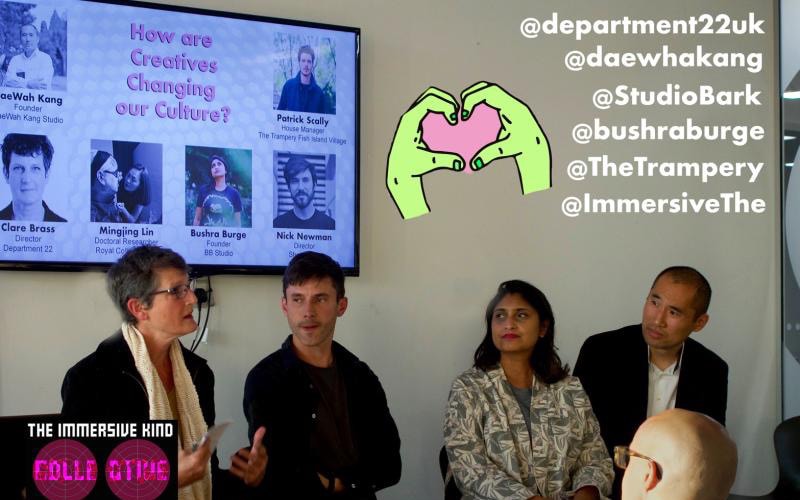
DaeWha gave a talk at the Immersive Kind Collective last week. A host of architects, urban designers, fashion designers, and product designers got together to share their work and discuss different ways that we are all trying to make a difference.
It was inspiring to see such a range of people all contributing in a different way. Nick Newman from Studio Bark spoke about the difficult decisions he has had to make to take climate change seriously. He has gone down to four days a week on paid work and a day a week focused on direct activism. Bridget McKenzie from Flow Associates has done the same, going down to several days a week while dedicating a great deal of her time to her project the Climate Museum UK.
Other work was more far-out. Alice V Robinson has been working deeply with material sourcing in fashion design, using every piece of a cow to design leather clothing and accessories with the minimum possible waste.
Aside from Nick, DaeWha also met Alasdair Ben Dixon, from Collective Works. We decided to meet up together on the 20th of September climate strike and share some knowledge together. More on that soon.
After last week’s discussion, we are aiming to educate ourselves one step at a time. After finishing the Uninhabitable Earth, DaeWha has started reading Drawdown: The Most Comprehensive Plan Ever Proposed to Reverse Global Warming. The book is a collection of experts’ assessment of the 100 most impactful strategies, in ranked order. He told the team he would be sharing what he learns each week.
Number 1 on the list is, surprisingly, refrigeration. Most of the refrigerants that we use in our appliances and our air conditioners can give off gases that are massively harmful for global warming. Some of these trap up to 9,000 times more heat than CO2. Removing these from people’s buildings and factories, safely transforming those that exist, and transitioning into already available cleaner refrigerants will have a massive impact on our fight.
The industry is aware of the risks and is working quickly to introduce statutory regulation and sanctions against countries that do not comply.
This doesn’t sound like something that immediately screams “design”, but we can certainly make an effort to design more passive buildings that don’t use air conditioning, and encourage discussion about the topic of food shipping, food refrigeration, and supply chains more broadly.
Another topic of discussion (considering Weronika’s upcoming holiday in New York) was carbon offsetting. We spoke last time about what kind of sacrifices each person would be willing to make for the environment. Would you be willing to stop seeing your family so that you fly less? Would you be willing to forgoe seeing parts of the world you have already wanted to see? One possible approach is to offset the carbon you use while flying. We dug a little bit into this.
Younha’s company, Atelier Ten, use Clear Carbon Offseting. We started with a little basic research while together in the office. Clear charge £9.99 + VAT for offsetting 1 ton of CO2. Weronika did a little research on the website and found that offsetting London to New York would cost her £20.00.
First thought: that is easy! Maybe DaeWha should offset his Berlin flights for the talk he is giving.
Second thought, that sounds far too cheap. Is there creative accounting happening there? Does this really work? If we all paid an extra 20 pounds on those flights, would we really go to zero net carbon for transport? We are deeply suspicious. More to check as we move along.
UK emissions in 2018 were estimated at 364 million tons of CO2. 64 million people in the UK = 5.7 tons per person. It might only be 57 pounds a year per person per year. But, to offset for the whole country is 3.6 billion pounds. DaeWha noted that this is actually a really big number. So maybe it seems easy for those of us who have spare cash to consider offsetting ourselves, but to roll it across society, including children and people out of work, could be much more difficult. Also, Laura wondered whether there are enough offsetting projects available at that scale.
To note: 3.6 billion pounds is 0.13% of GDP.
We are skeptical about all of these numbers. But it is our first stab at looking at them at all.
As a separate note:
Weronika brought up the water shortages in Capetown and Mexico City. She will send the Netflix link. Netflix, Series: Explained , season 1, episode 2: The World’s Water Crisis